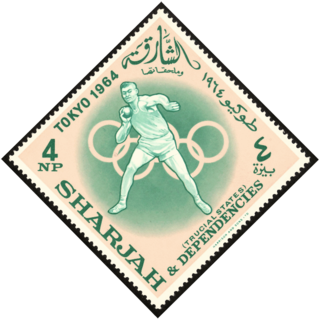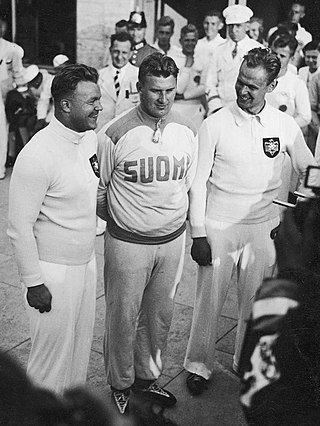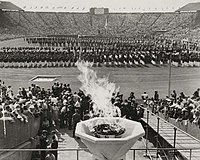
The men's shot put was one of four men's throwing events on the Athletics at the 1964 Summer Olympics program in Tokyo. It was held on 17 October 1964. 25 athletes from 15 nations entered, with 3 not starting in the qualification round. The maximum number of athletes per nation had been set at 3 since the 1930 Olympic Congress. The event was won by Dallas Long of the United States, the nation's fifth consecutive and 13th overall victory in the men's shot put. His teammate Randy Matson took silver, making 1964 the fifth straight Games the Americans had finished one-two. A second consecutive sweep was prevented when Vilmos Varju of Hungary took third over American Parry O'Brien. Long was the sixth man to win two shot put medals ; Matson would later become the seventh. O'Brien's fourth place finish kept him from being the first man to win four—he had taken gold in 1952 and 1956 and silver in 1960.

The men's shot put was one of six throwing events on the Athletics at the 1908 Summer Olympics programme in London. The competition was held on July 16, 1908. 25 shot putters from eight nations competed. NOCs could enter up to 12 athletes. The event was won by Ralph Rose, successfully defending his title from 1904 and making it four consecutive Games that the event was won by an American. The two-Games streak of sweeps in 1900 and 1904 ended, however, as Denis Horgan of Great Britain took silver. Johnny Garrels of the United States took bronze. Rose was the second man to win two medals in the shot put ; Wesley Coe nearly was the third as he ended up in 4th place, only 11 centimetres behind Garrels.

The men's shot put was an event at the 1956 Summer Olympics in Melbourne, Australia. The event was also known at the time as putting the weight. The qualifying round and the final both were held on Wednesday November 28, 1956. Fourteen shot putters from ten nations competed. The maximum number of athletes per nation had been set at 3 since the 1930 Olympic Congress.
The men's shot put was an event at the 1992 Summer Olympics in Barcelona, Spain. There were 26 participating athletes from 18 nations. The maximum number of athletes per nation had been set at 3 since the 1930 Olympic Congress. The event took place on 31 July 1992. The event was won by Mike Stulce of the United States, the nation's first victory in the men's shot put since 1968. His countryman Jim Doehring took silver. Vyacheslav Lykho of the Unified Team earned bronze, the first medal for a Soviet or former Soviet athlete in the event since 1980.
The men's shot put event at the 1988 Summer Olympics in Seoul, South Korea had an entry list of 21 competitors from 17 nations, with two qualifying groups before the final (12) took place on Friday September 23, 1988. The maximum number of athletes per nation had been set at 3 since the 1930 Olympic Congress. The event was won by Ulf Timmermann of East Germany, the nation's second victory in the men's shot put. Randy Barnes of the United States took silver, the second straight Games that an American finished second. Werner Günthör earned Switzerland's first medal in the event, a bronze.
The men's shot put event at the 2000 Summer Olympics as part of the athletics program was held at the Olympic Stadium on Friday, 22 September. The shot put has been ever present since the beginning of the modern Olympic Games in 1896. Thirty-seven athletes from 27 nations competed. The maximum number of athletes per nation had been set at 3 since the 1930 Olympic Congress. The qualifying athletes progressed through to the final where the qualifying distances were scrapped and they started afresh with up to six throws. The event was won by Arsi Harju of Finland, the nation's first victory in the men's shot put since 1920 and first medal in the event since 1936. Americans Adam Nelson and John Godina took silver and bronze, respectively, with Godina becoming the 12th man to earn multiple shot put medals.

The men's shot put event at the 1932 Olympic Games took place July 31. 15 athletes from 10 nations competed. The 1930 Olympic Congress in Berlin had reduced the limit from 4 athletes per NOC to 3 athletes. Leo Sexton of the United States won the gold medal, the nation's third consecutive and eighth overall victory in the men's shot put. It was also the third consecutive year the Americans took the top two places, as Harlow Rothert took silver. František Douda won Czechoslovakia's first shot put medal with a bronze.

The men's shot put event was part of the track and field athletics programme at the 1936 Summer Olympics. The competition was held on 2 August 1936. Twenty-two athletes from 14 nations competed. The maximum number of athletes per nation had been set at 3 since the 1930 Olympic Congress. The final was won by Hans Woellke of Germany. It was Germany's first victory in the men's shot put, and first medal since bronze in 1928. Germany also received bronze in 1936, with Gerhard Stöck finishing third. Between the two Germans was Sulo Bärlund of Finland with silver, the nation's first medal in the event since gold in 1920. For the first time, the United States won no medals in the men's shot put, with the three Americans finishing 4th, 5th, and 6th.

The men's triple jump event was part of the track and field athletics programme at the 1948 Summer Olympics. The competition was held on 3 August 1948. Twenty-eight athletes from 17 nations competed. The maximum number of athletes per nation had been set at 3 since the 1930 Olympic Congress. The final was won by Arne Åhman of Sweden. It was Sweden's first victory in the event since 1912, and first medal since 1932. Australia reached the podium for the second Games in a row with Gordon George Avery's silver. Turkey received a medal in its first appearance in the triple jump with Ruhi Sarialp's bronze; it was the only track and field athletics medal won by Turkey in the 1900s.

The men's high jump event was part of the track and field athletics programme at the 1948 Summer Olympics. The competition was held on July 30, 1948. Twenty-seven athletes from 16 nations competed. The maximum number of athletes per nation had been set at 3 since the 1930 Olympic Congress. The final was won by John Winter of Australia. It was Australia's first victory in the men's high jump, and only the second time a jumper from outside the United States had won. Bjorn Paulson earned Norway's first medal in the event with a silver. George Stanich took bronze, keeping alive the United States' streak of medaling in every edition of the men's high jump.

The men's discus throw event was part of the track and field athletics programme at the 1948 Summer Olympics. Twenty-eight athletes from 18 nations competed. The maximum number of athletes per nation had been set at 3 since the 1930 Olympic Congress. The competition was held on August 2. The final was won by Adolfo Consolini of Italy. It was the nation's first victory in the men's discus throw; Italy had previously taken bronze in 1936. Giuseppe Tosi earned silver to put Italy in the top two places. Fortune Gordien of the United States won bronze, keeping the Americans on the podium in each appearance of the men's discus throw to date.

The men's hammer throw event was part of the track and field athletics programme at the 1948 Summer Olympics. The competition was held on July 31. There were 24 competitors from 17 nations. The maximum number of athletes per nation had been set at 3 since the 1930 Olympic Congress. The final was won by Imre Németh of Hungary. It was the nation's first medal in the men's hammer throw. Ivan Gubijan of Yugoslavia took silver; that nation also earned its first medal in the event. Robert Bennett of the United States received the bronze medal, returning the American team to the podium after a one-Games absence.

The men's shot put throwing event at the 1960 Olympic Games took place on August 31. Twenty-four athletes from 16 nations competed. The maximum number of athletes per nation had been set at 3 since the 1930 Olympic Congress. The event was won by Bill Nieder of the United States, the nation's fourth consecutive and 12th overall victory in the men's shot put. Parry O'Brien and Dallas Long took silver and bronze, giving the American team its sixth medal sweep in the event. O'Brien, who had won gold in 1952 and 1956, matched Ralph Rose in coming just shy of a third gold medal. The two remain, through the 2016 Games, the only men to win three shot put medals. Nieder was the fifth man to win two medals.

The men's shot put event was part of the track and field athletics programme at the 1952 Summer Olympics in Helsinki, Finland. Twenty athletes from 14 nations competed. The maximum number of athletes per nation had been set at 3 since the 1930 Olympic Congress. The competition was held on 21 July at Helsinki Olympic Stadium. The finals were swept by the United States, with Americans Parry O'Brien taking the gold medal, Darrow Hooper earning silver and Jim Fuchs receiving his second consecutive bronze medal in the event. It was the 10th victory for an American in the event, and the fifth medal sweep for the United States. Fuchs was the third man to win multiple medals in the shot put.

The men's shot put competition at the 2012 Summer Olympics in London, United Kingdom was held at the Olympic Stadium on 3 August. Forty athletes from 34 nations competed. The event was won by Tomasz Majewski of Poland, the nation's second consecutive and third overall victory in the men's shot put. Majewski was the third man to successfully defend Olympic shot put gold, both of whom added a silver medal after their two golds). David Storl of Germany took silver, the first medal for united Germany since 1936. Reese Hoffa took bronze to keep the American podium streak going at eight consecutive Games.

The men's hammer throw competition at the 2012 Summer Olympics in London, United Kingdom was held at the Olympic Stadium on 3–5 August. There were 41 competitors from 32 nations. The event was won by Krisztián Pars of Hungary, the nation's first victory in the men's hammer throw since 1996 and fifth overall. Primož Kozmus of Slovenia, the 2008 winner, took silver. Koji Murofushi of Japan, the 2004 winner, took bronze. Kozmus and Murofoshi were the 12th and 13th men to earn multiple medals in the hammer throw.

The men's shot put field event at the 1972 Olympic Games took place on September 8 & 9. Twenty-nine athletes from 19 nations competed. The maximum number of athletes per nation had been set at 3 since the 1930 Olympic Congress.

The men's shot put competition at the 2016 Summer Olympics in Rio de Janeiro, Brazil. The event was held at the Olympic Stadium on 18 August. Thirty-four athletes from 24 nations competed. The event was won by Ryan Crouser of the United States, the nation's first victory in the event since 2004. His teammate Joe Kovacs took silver. Tomas Walsh earned New Zealand's first medal in the men's shot put.

The men's shot put event at the 2020 Summer Olympics took place between 3 and 5 August 2021 at the Japan National Stadium. Thirty-one athletes from 22 nations competed. For the first time in Olympic history, the same three competitors received the same medals in back-to-back editions of an individual event. Americans Ryan Crouser and Joe Kovacs and New Zealander Tom Walsh repeated their gold, silver, and bronze (respectively) performances from the 2016 Summer Olympics. They became the 15th, 16th, and 17th men to earn multiple medals in the shot put; Crouser was the 4th to repeat as champion.

The women's shot put event at the 2020 Summer Olympics is scheduled to take place on 30 July and 1 August 2021 at the Japan National Stadium. Approximately 35 athletes are expected to compete; the exact number will depend on how many nations use universality places to enter athletes in addition to the 32 qualifying through distance or ranking.

















